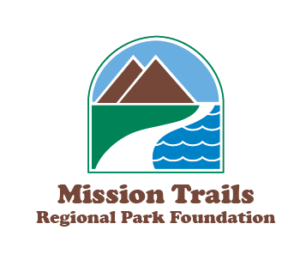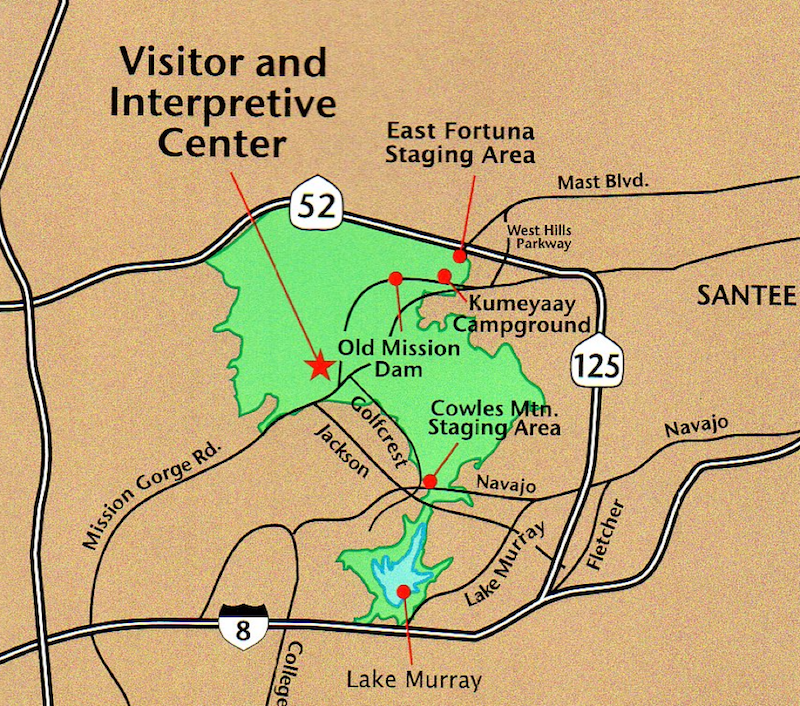Download pdf version of this page

Mission Trails Regional Park Foundation
One Father Junipero Serra Trail
San Diego, California 92119
www.mtrp.org
Dear Educator:
Thank you for your interest in Mission Trails Regional Park and for selecting it as a destination for your class field trip. The following information will assist you in preparing for your visit. There is a 15-student minimum for a guided field trip.
Reservations
Reservations are required for all group visits and classes. On-line reservations for Kindergarten through 8th grade school field trips may be made on our website at https://mtrp.org/foundation-fieldtrips/.
You will receive a field trip confirmation by e-mail within 7 days of your request if there are no conflicts. If there are conflicts or questions, we will contact you to arrange a different date or time before the field trip is confirmed.
Please advise of special needs or accommodations at least two weeks prior to your field trip.
Arrangements for the Overnight Campout may be made by contacting the Lead Educator directly at education@mtrp.org or 619-668-3280
Field Trip Guidelines
To ensure an enjoyable learning experience for everyone, please remember the following rules and guidelines; also, please be sure to discuss them with your class and adult chaperones before you arrive at the park for your scheduled field trip.
Supervision
- Student groups should have at least one adult chaperone for every eight children. It is asked that the adult leaders intersperse with the children while hiking, to monitor their activities and behavior. At stops, children are first.
- To avoid distracting students, adult chaperones should refrain from cell phone usage during the program, unless an emergency.
- Please note the Guide is a special resource, who can do a much better job for you if not burdened with unruly or unwilling participants. Teachers and adult chaperones are responsible for class control and discipline at ALL times; if the group becomes unmanageable, the Guide reserves the right to end the program at any time.
Proper Attire
Please remind everyone to wear sturdy, closed-toe shoes (no sandals) and clothes that are comfortable for hiking. Have students layer their clothing, to allow for a variety of weather conditions. During hotter months, please make sure that your students bring along water bottles; a hat and sunscreen are recommended.
Park Rules
- Please stay behind the leader and stay on the trail at all times.
- Please leave all rocks and sticks on the ground; do not remove any natural objects.
- All animals in the park are wildlife; please do not feed or attempt to handle
- Please be sure to throw all food scraps and trash in the garbage cans and recyclable items in the blue recycle bins.
- No running, please!
School Field Trip Transportation Reimbursement Procedure
- Field Trips are reimbursable up to $225 per bus.
- Invoicing must be done via the school district.
- Invoicing must occur no later than 30 days after the field trip.
- Invoices must be accompanied by actual transportation cost documentation.
- Invoices prior to field trip date will not be reimbursed.
- All invoices for June field trip transportation reimbursement must be received prior to June 30th.
Guided Programs
Listed below are descriptions of the guided programs offered for grades K-8th. One-day field trips include:
- Guided nature hike with an Education Program Instructor.
- Tour Visitor Center, including an educational scavenger hunt, the exhibits, and a video/presentation as time allows.
- Bus reimbursement up to $225 per trip.
K – 2nd Grade: The Habitats of Mission Trails Regional Park
Awareness of where we all live in relationship to San Diego’s cherished wildlife is the focus of this K-2nd grade outdoor education program. The concepts of habitat and the four elements necessary for one – food, water, shelter and space – are discussed in an introductory presentation. Students are then taken on an easy half-mile guided walk through some of the park’s native habitats, to see where some of the park’s many inhabitants live, and to discover some of the many signs and clues they leave behind. This 90-minute program begins and ends at the park’s Visitor Center. K-LS1-1, K-ESS3-1, K-ESS3-3, 1-LS1-1, 1-LS3-1, 2-LS2-1, 2-LS2-2, 2-LS4-1
3rd Grade: Kumeyaay Use of Mission Trails Regional Park
The Kumeyaay Indians are the indigenous people who once lived in the area that is now Mission Trails Regional Park. One of the more obvious dwelling sites used by the Kumeyaay includes a granitic bedrock area that has several depressions worn into the surface from hundreds of years of grinding acorns and other foods. This 3rd grade outdoor education program takes students on a one-mile roundtrip interpretive walk to the historic Grinding Rocks site at the edge of the San Diego River. Along the way, Kumeyaay usage of native plants and wildlife resources will be discussed. The cultural and social customs of the Kumeyaay, and their basic way of life, will also be covered. This program begins and ends at the Visitor Center, where students will also get the chance to view an educational video or storytelling presentation about the Kumeyaay, and participate in a Kumeyaay Scavenger Hunt through the museum. 3-LS3-2, 3-LS4-4, 3-5-ETS1-1, 3-5-ETS1-2
4th, 5th & 6th Grade: Ecosystems of Mission Trails Regional Park
Within the park there are seven distinct ecosystems – places where living and nonliving things interact. This one-mile exploratory walk takes students through four of the park’s dominant ecosystems – coastal sage scrub, chaparral, oak woodland and riparian. Students will have an opportunity to discover the differences between each ecosystem and learn why these differences exist. We’ll discuss animal species that may be found within each ecosystem (and, with hope, see some!), and identify soil composition. This program begins and ends at the park’s Visitor Center. 4-ESS2-1, 5 ESS2-1, 5-LS1-1, 5-LS2-1, MS-LS2-1, MS-LS-2-4
6th, 7th, & 8th Grade: Biodiversity of Mission Trails Regional Park
Human beings are living organisms who interact with and benefit greatly from the ecosystems around them. Ecosystems that have a greater variety of different species of plants and animals have a greater biodiversity. These ecosystems are also healthier and more stable. The field trip will emphasize biodiversity, human impact on the environment, and stewardship. It will include a discussion about biodiversity and students examining the biodiversity they observe along the nature walk. Students will learn about stewardship and how they can be stewards for the environment, including a video about stewardship, which focuses on the stewardship involved with Mission Trails Regional Park. This program begins and ends at the park’s Visitor Center. MS-LS2-1, MS-LS2-2, LS2.C (MS-LS2-4, MS-LS2-5)
Mission Trails Regional Park
The City of San Diego Park and Recreation Department’s Open Space Division manages Mission Trails Regional Park, a more than 7,000-acre natural and developed recreational area. There are approximately 60 miles of trails throughout the park, including the areas of Cowles Mountain and Lake Murray. Seven native habitats are found within the park boundaries, including Chaparral, Coastal Sage Scrub, Oak Woodland, Riparian, Aquatic, Grasslands and Vernal Pools. Old Mission Dam, both a State and National Registered Historic Landmark, is also located in the park.
A beautiful Visitor & Interpretive Center, with informative and interactive exhibits, a theater, library and gift shop, is also on site and not to be missed. The Visitor Center is open seven days a week from 9 a.m. to 5 p.m. and is free to the public. School groups may bring in their lunches and store them on a cart behind the front desk until lunch time; there is a large outdoor amphitheater on the back terrace of the Visitor Center, or a picnic area located on the west side of the Visitor Center where groups may enjoy their lunch. Informative video presentations about the park are shown in the theater upon request and range in length from 13 to 24 minutes (see descriptions below).
Park Video Presentations
- “Mission Trails Regional Park – A Natural Beauty” – A 13-minute inspirational video all about the park.
- “Link to the Past – A 15-minute informative video presentation about Mission Trails Regional Park from past to present.
- “Trails of the Kumeyaay”- A 16-minute video about the traditions, cultural practices and lifestyle of the Kumeyaay from the distant past and into the present. Please note, there is an art sketch of a Kumeyaay village shown briefly, which depicts partial nudity.
- “Stewardship Through the Ages” – A 24-minute video, narrated by Fox 5 San Diego newsman Loren Nancarrow, about the ownership and usage of the land that is now Mission Trails Park.
Directions
 From Interstate 8 – Exit Mission Gorge/Fairmount and turn north onto Mission Gorge Road. At the Friars Road junction, turn right to stay on Mission Gorge Road, and follow it east for 4.2 miles. Just past the Jackson Drive intersection, turn left onto Father Junipero Serra Trail. To get to the Visitor Center, turn left into the parking lot entrance, just before you get to the half-closed road.
From Interstate 8 – Exit Mission Gorge/Fairmount and turn north onto Mission Gorge Road. At the Friars Road junction, turn right to stay on Mission Gorge Road, and follow it east for 4.2 miles. Just past the Jackson Drive intersection, turn left onto Father Junipero Serra Trail. To get to the Visitor Center, turn left into the parking lot entrance, just before you get to the half-closed road.
From Route 52 – Exit Mast Blvd. in Santee. Turn north onto Mast Blvd. and then right at the 1st traffic signal (West Hills Parkway). Take West Hills Parkway to Mission Gorge Road and turn right. To get to the Visitor Center, stay left at the merge and take Mission Gorge Road west 2.4 miles. After you pass the light at Golfcrest Drive, turn right onto Father Junipero Serra Trail. The entrance to the parking lot is located on the left, just before you get to the half-closed road.
